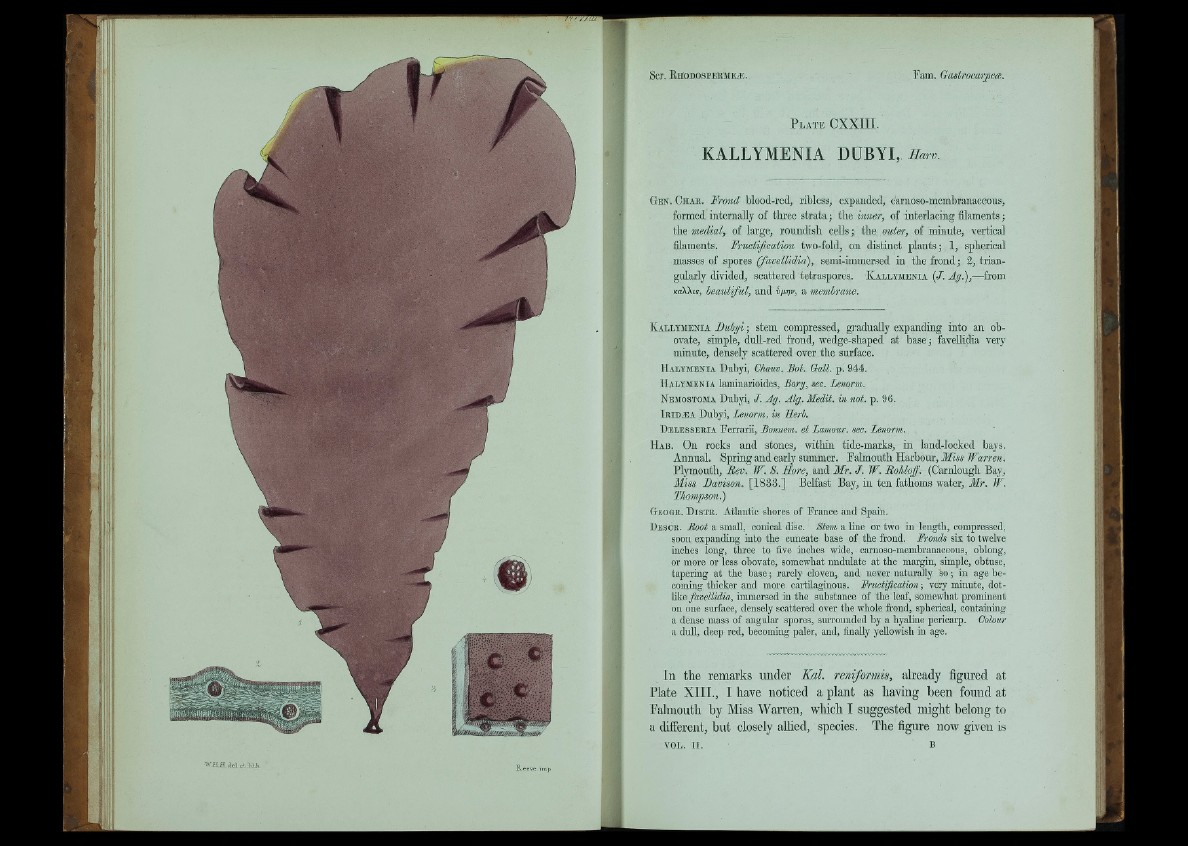
WJLH.dcltt.10k
P l a t e CXXIII.
KALLYMENIA DUBYI, Harv.
Gen. C h a e . Frond blood-red, ribless, expanded, carnoso-membranaoeous,
formed internally of three strata; the inner, of interlacing filaments;
the medial, of large, roundish cells; the outer, of minute, vertical
filaments. Fructification two-fold, on distinct plants; 1, spherical
masses of spores (favellidia), semi-immersed in the frond; 3, triangularly
divided, scattered tetraspores. K a lltm e n ia (/. A g .),-—from
jcaXXis, beautiful, and vgr^v, a membrane.
K a l l y m e n i a D u b y i; stem compressed, gradually expanding into an ob-
ovate, simple, dull-red frond, wedge-shaped at base; favellidia very
minute, densely scattered over the surface.
H alymenia Dubyi, Cliauv. Bot. Gall. p. 944.
H alymenia laminarioides, Borg, sec. Lenorm.
N em o s tom a Dubyi, / . Ag. Alg. Medit. in not. p. 96.
I r i d e a Dubyi, Lemrm. in Herb,
Dblesseria Ferrarii, Bonnern, et Lamour. sec. Lenorm.
H a b . On rocks and stones, within tide-marks, in land-locked bays.
Annual. Spring and early summer. Falmouth Harbour, Miss Warren.
Plymouth, Rev. W. 8. Flore, and M r. J . W. Rohloff. (Carnlough Bay,
Miss Davison. [1833.] BeKast Bay, in ten fathoms water, Mr. W.
Thompson.)
Geogr. D is t r . Atlantic shores of France and Spain.
Desck. Root a small, conical disc. Stem a line or two in length, compressed,
soon expanding into the cuneate base of the frond. Fronds six to twelve
inches long, three to five inches wide, carnoso-membranaceous, oblong,
or more or less obovate, somewhat nndulate at the margin, simple, obtuse,
tapering a t the b a s e ; rarely cloven, and never natm-ally s o ; in age be coming
thicker and more cartilaginous. Fructification; very minute, dot-
hke favellidia, immersed iu the substance of the leaf, somewhat prominent
on one sui-face, densely scattered over the whole frond, spherical, containing
a dense mass of angular spores, surrounded by a hyaline pericarp. Colour
a dull, deep red, becoming paler, and, finally yellowish in age.
In the remarks under Kal. reniformis, already figured at
Plate XIII., I have noticed a plant as having been found at
Falmouth by Miss Warren, which I suggested might belong to
a different, but closely allied, species. The figure now given is
VOL. I t . B